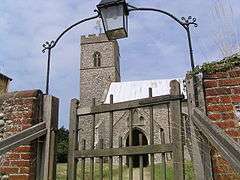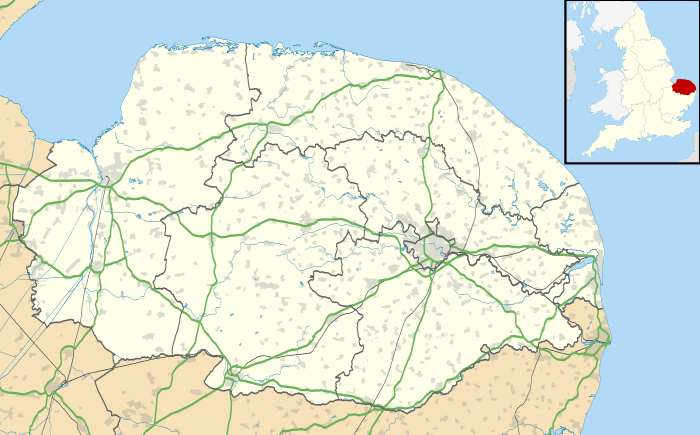Knapton
| Knapton | |
 Knapton Parish Church |
|
 Knapton |
|
| Area | 5.80 km2 (2.24 sq mi) |
|---|---|
| Population | 364 (2011 census)[1] |
| – density | 63/km2 (160/sq mi) |
| OS grid reference | TG305340 |
| – London | 134 miles (216 km) |
| Civil parish | Knapton |
| District | North Norfolk |
| Shire county | Norfolk |
| Region | East |
| Country | England |
| Sovereign state | United Kingdom |
| Post town | NORTH WALSHAM |
| Postcode district | NR28 |
| Dialling code | 01263 |
| Police | Norfolk |
| Fire | Norfolk |
| Ambulance | East of England |
| EU Parliament | East of England |
| UK Parliament | North Norfolk |
Coordinates: 52°51′N 1°25′E / 52.85°N 1.42°E
Knapton is a village and a civil parish in the English county of Norfolk.[2] The village is 8.9 miles (14.3 km) south-east of Cromer, 19.4 miles (31.2 km) north-east of Norwich and 134 miles (216 km) north-east of London. The Village is located alongside the B1145[3] a route which runs between King's Lynn and Mundesley. The nearest railway station is at North Walsham for the Bittern Line which runs between Sheringham, Cromer and Norwich. The nearest airport is Norwich International Airport.
History
Knapton is mentioned in the Domesday Book of 1086 where it is listed under the name ‘Kanapatone’.[4] The tenant in chief was William de Warenne[5] who was a Norman aristocrat who fought at the Battle of Hastings and became great landowners in England.
Saint Peter and Saint Paul Parish Church
The present church dates from mainly the 14th century.[6] The tower is set into the north west corner of the building. The porch is on the southern elevation. Atop of the church there is a weathervane designed by J.S. Cotman[7] an artist famed as a member of the Norwich school. Inside there is a 13th-century font on three high steps which has a Purbeck marble bowl and a cover over which dates from 1704. The inscription which is in Greek reads “wash my sins and not my face only”[7] The inscription is a palindrome, reading the same backwards as forwards.. At the back of the church behind the font there are some coffin-lids[7] from the earlier church set into the flags of the floor. The most prominent feature of this church is the roof. The roof was given to the church by a John Smithe in 1504. It is of a double hammerbeam[6] construction and still retains its original colour. The beams and spandrels are richly carved with three tiers of angels which have outspread wings. More angels are carved on the kingposts and on the wall plate. In niches below the wall supports there are figures with scrolls, shields, symbols or playing musical instruments. The church is a Grade I listed building .
Church Gallery
- The covered Font
.jpg) Some of the carved angels
Some of the carved angels- The double hammerbeam roof
References
- ↑ "Parish population 2011". Retrieved 31 August 2015.
- ↑ Ordnance Survey, Explorer Sheet 252, Norfolk Coast East, ISBN 978-0-319-46726-8
- ↑ County A to Z Atlas, Street & Road maps Norfolk, page 230 ISBN 978-1-84348-614-5
- ↑ The Domesday Book, Englands Heritage, Then and Now, Editor: Thomas Hinde,Norfolk page 191 ISBN 1-85833-440-3
- ↑ William the Conqueror by David C Douglas, 1964, ISBN 0-300-07884-6
- 1 2 Norfolk 1: Norwich and North-East, By Nikolaus Pevsner and Bill Wilson, Knapton entry. ISBN 0-300-09607-0
- 1 2 3 The King’s England, Norfolk, by Arthur Mee, Page 152 ISBN 0-340-15061-0
External links
External links
![]() Media related to Knapton at Wikimedia Commons
Media related to Knapton at Wikimedia Commons
